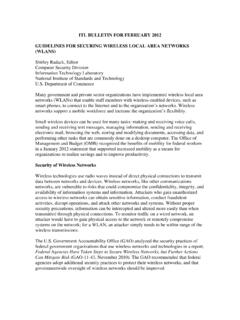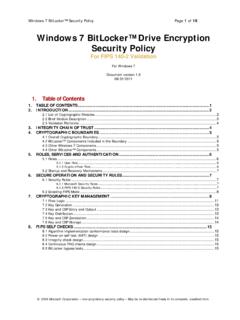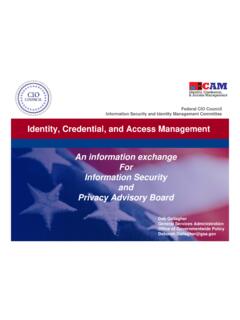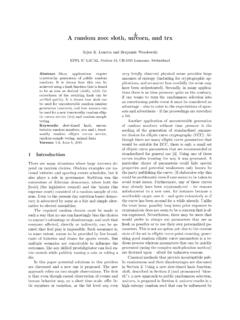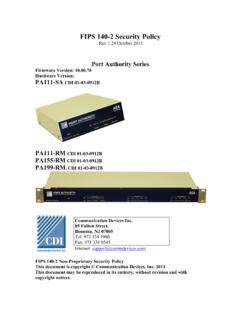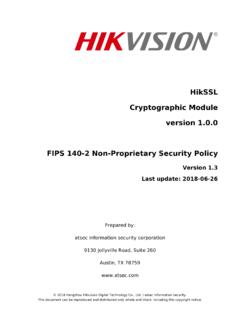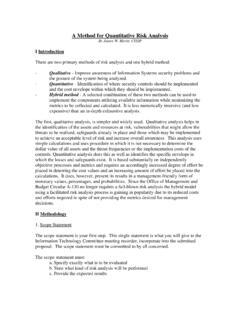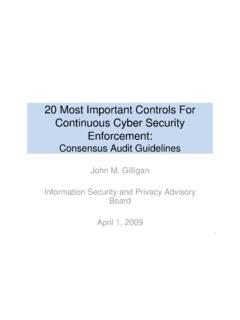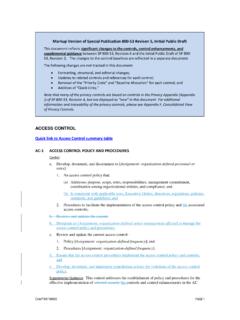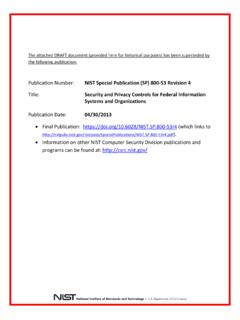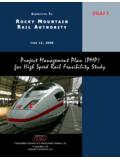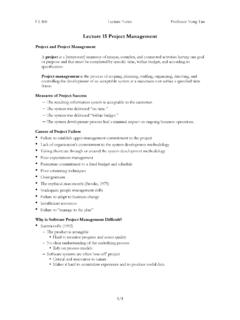Transcription of Impact Levels and Security Controls - NIST
1 NATIONAL INSTITUTE OF STANDARDS AND TECHNOLOGY 1 Dr. Ron Ross Computer Security Division Information Technology Laboratory Impact Levels and Security Controls Understanding FIPS 199, FIPS 200 and SP 800-53 NIST Cryptographic Key Management Workshop March 5, 2014 NATIONAL INSTITUTE OF STANDARDS AND TECHNOLOGY 2 TIER 3 Information System (Environment of Operation) TIER 2 Mission / Business Process (Information and Information Flows) TIER 1 Organization (Governance) STRATEGIC (EXECUTIVE) RISK FOCUS TACTICAL (OPERATIONAL) RISK FOCUS Communicating and sharing risk-related information from the strategic to tactical level, that is from the executives to the operators. Communicating and sharing risk-related information from the tactical to strategic level, that is from the operators to the executives.
2 NATIONAL INSTITUTE OF STANDARDS AND TECHNOLOGY Risk Management Framework Security Life Cycle Determine Security control effectiveness ( , Controls implemented correctly, operating as intended, meeting Security requirements for information system). ASSESS Security Controls Define criticality/sensitivity of information system according to potential worst-case, adverse Impact to mission/business. CATEGORIZE Information System Starting Point Continuously track changes to the information system that may affect Security Controls and reassess control effectiveness. MONITOR Security Controls AUTHORIZE Information System Determine risk to organizational operations and assets, individuals, other organizations, and the Nation; if acceptable, authorize operation.
3 Implement Security Controls within enterprise architecture using sound systems engineering practices; apply Security configuration settings. IMPLEMENT Security Controls SELECT Security Controls Select baseline Security Controls ; apply tailoring guidance and supplement Controls as needed based on risk assessment. 3 NATIONAL INSTITUTE OF STANDARDS AND TECHNOLOGY 4 FIPS 199 Security Objectives CONFIDENTIALITY Preserving authorized restrictions on information access and disclosure, including means for protecting personal privacy and proprietary A loss of confidentiality is the unauthorized disclosure of information INTEGRITY Guarding against improper information modification or destruction.
4 And includes ensuring information non-repudiation and A loss of integrity is the unauthorized modification or destruction of information AVAILABILITY Ensuring timely and reliable access to and use of A loss of availability is the disruption of access to or use of information or an information system NATIONAL INSTITUTE OF STANDARDS AND TECHNOLOGY 5 Security Categorization FIPS 199 LOW MODERATE HIGH Confidentiality The loss of confidentiality could be expected to have a limited adverse effect on organizational operations, organizational assets, or individuals. The loss of confidentiality could be expected to have a serious adverse effect on organizational operations, organizational assets, or individuals.
5 The loss of confidentiality could be expected to have a severe or catastrophic adverse effect on organizational operations, organizational assets, or individuals. Integrity The loss of integrity could be expected to have a limited adverse effect on organizational operations, organizational assets, or individuals. The loss of integrity could be expected to have a serious adverse effect on organizational operations, organizational assets, or individuals. The loss of integrity could be expected to have a severe or catastrophic adverse effect on organizational operations, organizational assets, or individuals. Availability The loss of availability could be expected to have a limited adverse effect on organizational operations, organizational assets, or individuals.
6 The loss of availability could be expected to have a serious adverse effect on organizational operations, organizational assets, or individuals. The loss of availability could be expected to have a severe or catastrophic adverse effect on organizational operations, organizational assets, or individuals. Baseline Security Controls for High Impact Systems Guidance for Mapping Types of Information and Information Systems to FIPS 199 Security Categories SP 800-60 NATIONAL INSTITUTE OF STANDARDS AND TECHNOLOGY 6 Security Controls The safeguards or countermeasures prescribed for an information system to protect the confidentiality, integrity, and availability of the system and its information.
7 NATIONAL INSTITUTE OF STANDARDS AND TECHNOLOGY 7 Security Controls Provide functionality and assurance. What is observable in front of the wall. What is observable behind the wall. FUNCTIONALITY ASSURANCE NATIONAL INSTITUTE OF STANDARDS AND TECHNOLOGY 8 Assurance and Trustworthiness TRUSTWORTHINESS (Systems and Components) Facilitates risk response to a variety of threats, including hostile cyber attacks, natural disasters, structural failures, and human errors, both intentional and unintentional. Enables Security Requirements Derived from Laws, , Policies, Directives, Instructions, Mission/Business Needs, Standards Satisfies Security Capability Mutually Reinforcing Security Controls (Technical, Physical, Procedural Means) Produces Security Functionality Features, Functions, Services, Mechanisms, Processes, Procedures (Functionality-Related Controls )
8 Promotes Traceability from Requirements to Capability to Functionality with Degree of Assurance Security Evidence Development Artifacts, Flaw Reports, Assessment Results, Scan Results, Integrity Checks, Configuration Settings Generates Provides Confidence In Security Assurance Developmental/Operational Actions (Assurance-Related Controls ) NATIONAL INSTITUTE OF STANDARDS AND TECHNOLOGY 9 NIST SP 800-53 Security Control Families ID FAM I LY AC Access Control AT Awareness and Training AU Audit and Accountability CA Security Assessment and Authorization CM Configuration Management CP Contingency Planning IA Identification and Authentication IR Incident Response MA Maintenance MP Media Protection PE Physical and Environmental Protection PL Planning PS Personnel Security RA Risk Assessment SA System and Services Acquisition SC System and Communications Protection SI System and Information Integrity PM Program Management NATIONAL INSTITUTE OF STANDARDS AND TECHNOLOGY 10 Control Naming Convention AC-9 PREVIOUS LOGON
9 (ACCESS) NOTIFICATION Control: The information system notifies the user, upon successful interactive logon (access) to the system, of the date and time of the last logon (access). Supplemental Guidance: This control is intended to cover both traditional logons to information systems and accesses to systems that occur in other types of architectural configurations ( , service oriented architectures). Related Controls : AC-7, PL-4. Control Enhancements: (1) PREVIOUS LOGON NOTIFICATION | UNSUCCESSFUL LOGONs The information system notifies the user, upon successful logon/access, of the number of unsuccessful logon/access attempts since the last successful logon/access.
10 (2) PREVIOUS LOGON NOTIFICATION | SUCCESSFUL/UNSUCCESSFUL LOGONS The information system notifies the user of the number of [Selection: successful logons/accesses; unsuccessful logon/access attempts; both] during [Assignment: organization-defined time period]. NATIONAL INSTITUTE OF STANDARDS AND TECHNOLOGY 11 Security Control Baselines Starting point for the Security control selection process. Chosen based on the Security category and associated Impact level of the information system determined in accordance with FIPS 199 and FIPS 200, respectively. Three sets of baseline Controls have been identified corresponding to low- Impact , moderate- Impact , and high- Impact information system Levels .
